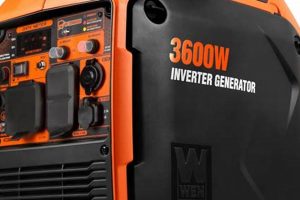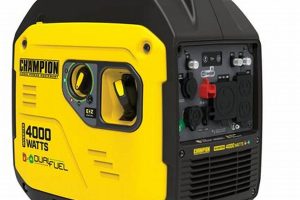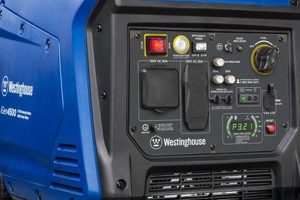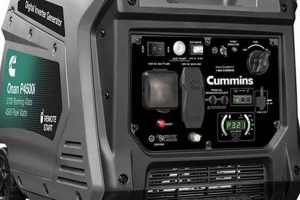Choosing between an inverter generator and a conventional portable generator involves understanding the distinct technologies and their respective advantages. An inverter generator uses advanced electronics to produce a stable, pure sine wave output, ideal for sensitive electronics like laptops and medical equipment. A conventional portable generator, while typically more affordable, produces a less refined power output. This difference in power quality significantly impacts the suitability of each type for various applications.
The increasing reliance on portable power solutions for both recreational activities and emergency preparedness highlights the importance of this distinction. Historically, portable generators primarily powered construction tools and other equipment tolerant of fluctuating power. However, the proliferation of sensitive electronics in everyday life necessitates a cleaner power source, a need fulfilled by inverter technology. This evolution in portable power has expanded the range of applications, from powering campsites to providing backup power during outages.
This article will further explore the key differences between these two generator types, delving into factors such as fuel efficiency, noise levels, portability, and cost, ultimately equipping readers with the information necessary to select the optimal power solution for their specific needs.
Tips for Selecting Between Inverter and Conventional Portable Generators
Choosing the right generator requires careful consideration of power needs, budget, and the intended applications. These tips offer guidance for navigating the selection process.
Tip 1: Assess Power Requirements: Calculate the total wattage required to run the intended devices simultaneously. Inverter generators are suitable for smaller loads and sensitive electronics, while conventional generators handle higher wattage demands.
Tip 2: Prioritize Power Quality: For sensitive electronics like laptops, smartphones, and medical devices, the clean power delivered by an inverter generator is crucial to prevent damage.
Tip 3: Consider Noise Tolerance: Inverter generators generally operate at lower noise levels, making them ideal for campsites or noise-sensitive environments. Conventional generators tend to be louder.
Tip 4: Evaluate Fuel Efficiency: Inverter generators often offer better fuel efficiency, particularly at lower loads, due to their variable engine speed. This translates to longer run times and reduced fuel costs.
Tip 5: Factor in Portability: Consider the weight and size of the generator, especially if frequent transport is anticipated. Inverter generators are often lighter and more compact than conventional models of comparable power output.
Tip 6: Analyze Budgetary Constraints: Inverter generators typically carry a higher price tag. Balance the benefits of cleaner power and quieter operation against the cost difference compared to conventional generators.
Tip 7: Research Reliability and Warranty: Look for reputable brands with established track records for reliability and comprehensive warranty coverage for both generator types.
Careful consideration of these factors ensures selection of the most appropriate generator type, providing reliable and efficient power for diverse needs. These tips empower informed decisions, optimizing both performance and value.
By understanding the nuances of each generator type and aligning them with specific requirements, consumers can confidently choose a portable power solution that meets their individual needs. This informed approach ultimately leads to a more satisfactory and efficient power experience.
1. Power Quality
Power quality represents a critical differentiator between inverter and conventional portable generators. It directly impacts the safe and effective operation of connected devices, particularly sensitive electronics. Understanding the nuances of power quality is essential for selecting the appropriate generator for specific applications.
- Total Harmonic Distortion (THD)
THD measures the distortion present in the generator’s output waveform. Inverter generators produce a cleaner sine wave with significantly lower THD, typically less than 5%. Conventional generators exhibit higher THD, potentially exceeding 20%, which can damage sensitive electronic equipment. This distinction makes inverter generators suitable for powering devices like laptops, smartphones, and medical equipment.
- Voltage Regulation
Voltage regulation refers to the generator’s ability to maintain a consistent voltage output under varying loads. Inverter generators excel in voltage regulation due to their electronic control systems, ensuring a stable power supply even during load fluctuations. Conventional generators offer less precise voltage regulation, potentially causing issues for devices requiring a consistent voltage input.
- Frequency Stability
Frequency stability, measured in Hertz (Hz), indicates the consistency of the alternating current’s cycles per second. Inverter generators maintain a stable frequency, typically 60Hz in North America, regardless of the load. Conventional generators can experience frequency fluctuations, especially with changing loads, potentially affecting the performance of some appliances and tools.
- Clean Power for Sensitive Electronics
The clean power delivered by inverter generators, characterized by low THD, stable voltage, and consistent frequency, is crucial for protecting sensitive electronics. These devices, often containing intricate circuitry, are susceptible to damage from the fluctuating and distorted power produced by conventional generators. The consistent power quality of inverter generators safeguards these devices, ensuring reliable and safe operation.
The differences in power quality between inverter and conventional generators significantly influence their suitability for various applications. While conventional generators suffice for powering basic tools and appliances tolerant of power fluctuations, inverter generators are essential for protecting sensitive electronics and ensuring their optimal performance. Selecting the appropriate generator type based on power quality needs ensures both the longevity of connected devices and the reliability of the power supply.
2. Fuel Efficiency
Fuel efficiency plays a significant role in the operational cost and practicality of portable generators. The choice between an inverter generator and a conventional portable generator significantly impacts fuel consumption and overall runtime. Understanding the factors influencing fuel efficiency is crucial for selecting the most suitable generator for specific needs.
- Variable Speed Technology
Inverter generators utilize variable speed technology, also known as Eco-Throttle or similar terms. This feature allows the engine speed to adjust dynamically based on the power demand. Under lighter loads, the engine slows down, reducing fuel consumption. Conventional generators typically operate at a fixed speed, regardless of the load, resulting in higher fuel consumption, particularly when operating below maximum capacity. This key difference often translates to substantial fuel savings over extended periods with an inverter generator.
- Load-Dependent Fuel Consumption
The fuel consumption of an inverter generator directly correlates with the power demand. At lower loads, fuel consumption decreases proportionally, maximizing efficiency. Conversely, conventional generators consume a relatively consistent amount of fuel regardless of the load. This makes inverter generators more economical for applications with fluctuating power requirements.
- Run Time and Fuel Capacity
While inverter generators often have smaller fuel tanks than conventional generators, their enhanced fuel efficiency can result in comparable or even longer run times, especially at partial loads. Calculating the estimated runtime based on the generator’s fuel capacity and expected load is crucial for ensuring uninterrupted power for the desired duration.
- Cost Savings Over Time
The initial higher cost of an inverter generator can be offset over time by the fuel savings achieved through its variable speed technology and load-dependent fuel consumption. For frequent or extended use, the cumulative fuel savings can make an inverter generator a more economical choice in the long run.
The fuel efficiency considerations significantly impact the overall cost of ownership and the practical usability of a portable generator. Inverter generators, with their variable speed technology and load-dependent fuel consumption, offer substantial advantages in terms of fuel economy, particularly for users with varying power demands. Evaluating fuel efficiency alongside other factors like power output and noise level ensures the selection of the most appropriate and cost-effective generator for individual needs.
3. Noise Levels
Noise levels represent a critical factor differentiating inverter and conventional portable generators. This distinction significantly impacts their suitability for various environments, from residential use to recreational activities. Conventional generators operate at consistently high engine speeds, resulting in substantial noise output, often exceeding 70 decibels. This level can disrupt conversations, disturb neighbors, and negatively impact the enjoyment of outdoor activities. Inverter generators, conversely, employ variable engine speed technology. Under lighter loads, the engine speed reduces, consequently lowering noise output, often to levels below 60 decibels, comparable to normal conversation. This quieter operation makes them ideal for noise-sensitive environments such as campsites, residential areas, and events.
The practical implications of these differing noise levels are significant. For instance, using a conventional generator in a densely populated area could lead to noise complaints, while an inverter generator would likely operate unobtrusively. Similarly, during a camping trip, a conventional generator’s noise could disrupt the tranquility of the natural setting, whereas an inverter generator would allow for peaceful enjoyment. Furthermore, individuals working in noise-sensitive professions, such as sound recording or broadcasting, would find the quieter operation of an inverter generator essential for maintaining a professional environment. The difference in noise output also impacts usability during power outages. Inverter generators permit communication and avoid exacerbating already stressful situations.
Noise considerations play a crucial role in generator selection. Understanding the difference in noise output between inverter and conventional generators empowers informed decisions. This awareness ensures the chosen generator aligns with the specific environmental needs, promoting peaceful coexistence and enhancing user experience. The selection process should prioritize noise levels alongside other critical factors such as power output and fuel efficiency to achieve the optimal balance of functionality and environmental impact.
4. Portability
Portability represents a key factor influencing the selection between inverter and conventional portable generators. Weight and dimensions directly impact ease of transport and storage, crucial considerations for various applications. Inverter generators generally offer a significant advantage in portability due to their compact design and lighter weight. This stems from their more efficient use of engine power and smaller engine size required for a given power output. Conventional generators, while often offering higher maximum power, tend to be bulkier and heavier due to larger engines and more robust construction necessary to handle higher loads. This difference in portability can be substantial, sometimes amounting to a difference of tens of pounds for comparable power outputs.
Consider a scenario requiring transport of a generator over rough terrain, such as a campsite or remote worksite. The lighter weight and more compact size of an inverter generator significantly simplifies this task. Similarly, for users with limited storage space, the smaller footprint of an inverter generator proves advantageous. Conversely, applications requiring high power output for extended periods, such as construction sites, might necessitate the more robust, albeit less portable, conventional generator. The practical implications of portability extend beyond mere convenience. In emergency situations, such as natural disasters, the ability to quickly and easily move a generator can be crucial. The lighter weight of an inverter generator allows for faster deployment and easier maneuvering in challenging conditions.
Selecting a generator based solely on portability without considering power requirements and other factors can lead to an inadequate power supply or unnecessary strain. A comprehensive evaluation considering power needs, noise levels, fuel efficiency, and portability ensures the chosen generator effectively meets all requirements. Understanding the interplay of these factors empowers informed decisions aligned with the specific demands of each application, maximizing both practicality and efficiency.
5. Cost
Cost represents a significant factor influencing the decision-making process when choosing between inverter and conventional portable generators. Inverter generators typically command a higher initial price compared to conventional generators with equivalent power output. This price difference stems from the more complex technology employed in inverter generators, including sophisticated electronic circuitry and advanced components responsible for producing cleaner and more stable power. Conventional generators, relying on simpler mechanical components and less intricate designs, generally offer a more budget-friendly initial investment. This cost disparity can be substantial, potentially ranging from several hundred to over a thousand dollars depending on the power output and features.
However, a comprehensive cost analysis extends beyond the initial purchase price. Operational costs, primarily fuel consumption, play a crucial role in long-term expenses. Inverter generators, due to their variable speed technology, often exhibit superior fuel efficiency, particularly under varying loads. This translates to lower fuel costs over time, potentially offsetting the higher initial investment, especially for frequent or prolonged use. Conventional generators, operating at fixed speeds, consume more fuel, particularly at lower loads, leading to potentially higher operational costs over the generator’s lifespan. Therefore, consumers should consider anticipated usage patterns and long-term cost implications. A higher initial investment in an inverter generator could prove more economical in the long run for users requiring frequent operation or powering sensitive electronics.
Ultimately, a balanced cost assessment requires considering both the initial investment and long-term operational expenses. Evaluating the intended use case, required power output, and expected frequency of use informs a comprehensive cost-benefit analysis. This holistic approach empowers informed purchasing decisions, optimizing both short-term budgetary considerations and long-term cost efficiency. Recognizing the interplay between initial purchase price and operational costs ensures selection of the most appropriate generator type aligned with individual needs and financial constraints.
6. Maintenance
Regular maintenance is crucial for the longevity and reliable performance of both inverter and conventional portable generators. While the underlying principles of engine maintenance remain consistent, specific requirements and procedures can vary depending on the generator type. Understanding these nuances ensures optimal performance and extends the lifespan of the investment.
- Engine Oil Changes
Regular engine oil changes are essential for both generator types. Frequency varies based on operating hours and manufacturer recommendations, typically every 50-100 hours. Inverter generators, often operating at lower speeds and temperatures, may extend oil change intervals compared to conventional generators subjected to higher loads and temperatures. Using the recommended oil type and viscosity is crucial for optimal engine performance and longevity.
- Air Filter Maintenance
Clean air filters are essential for proper combustion and engine performance. Frequency of cleaning or replacement depends on operating environment and usage. Inverter generators, often operating in cleaner environments, might require less frequent air filter maintenance compared to conventional generators used in dusty or debris-laden environments. Regular inspection and timely cleaning or replacement prevent reduced airflow, impacting engine efficiency and increasing fuel consumption.
- Spark Plug Replacement
Spark plugs ignite the fuel-air mixture within the engine cylinder, impacting combustion efficiency. Regular replacement, typically every 25-50 operating hours or as recommended by the manufacturer, maintains optimal engine performance. Inverter generators, due to their variable speed operation, might experience different spark plug wear patterns compared to conventional generators. Using the correct spark plug type ensures efficient ignition and prevents engine damage.
- Fuel System Maintenance
Proper fuel system maintenance is vital for both generator types. This includes draining the fuel tank during periods of extended storage to prevent fuel degradation and potential carburetor issues. Inverter generators, often featuring more sophisticated fuel systems, might require more specialized maintenance procedures. Regularly checking and cleaning fuel lines and filters prevents blockages and ensures optimal fuel delivery.
While both inverter and conventional generators share fundamental maintenance requirements, understanding the specific needs of each type optimizes performance and extends lifespan. Inverter generators, due to their variable speed operation and often cleaner operating environments, may require less frequent maintenance for certain components compared to conventional generators. Adhering to the manufacturer’s recommended maintenance schedule for the specific generator model ensures reliable and efficient operation, maximizing the return on investment.
7. Applications
The choice between an inverter generator and a conventional portable generator hinges significantly on the intended application. Each type excels in specific scenarios due to inherent differences in power quality, noise output, and portability. Understanding these distinctions is crucial for selecting the appropriate generator to meet specific power needs effectively.
Inverter generators, renowned for clean power output, are ideally suited for powering sensitive electronics. Common applications include:
- Recreational activities: Camping, tailgating, and RVing benefit from the quiet operation and clean power for laptops, smartphones, and other electronic devices.
- Emergency backup power: During power outages, inverter generators provide safe and reliable power for essential household appliances, including refrigerators, sump pumps, and medical equipment.
- Professional use: Photographers, videographers, and sound engineers rely on inverter generators to power sensitive equipment on location.
Conventional portable generators, prioritizing higher power output and affordability, find their niche in applications requiring robust power delivery. Typical uses include:
- Construction sites: Powering tools like saws, drills, and air compressors demands the higher wattage typically offered by conventional generators.
- Emergency power for essential appliances: While inverter generators are preferred for sensitive electronics, conventional generators can power basic appliances like lights and fans during outages.
- Backup power for small businesses: Certain businesses may rely on conventional generators for temporary power during outages to maintain essential operations.
Mismatches between generator type and application can lead to suboptimal performance and potential equipment damage. Attempting to power sensitive electronics with a conventional generator risks damage from fluctuating voltage and distorted power output. Conversely, using an inverter generator for heavy-duty power tools may overload the generator and compromise its lifespan. Careful consideration of the intended application, power requirements, and the specific characteristics of each generator type is paramount for ensuring efficient and safe operation. Selecting the appropriate generator ensures optimal performance, equipment protection, and overall satisfaction with the power solution.
Frequently Asked Questions
This section addresses common inquiries regarding the selection and operation of inverter and conventional portable generators. Clarity on these points assists in making informed decisions tailored to specific power needs.
Question 1: Which generator type is best for sensitive electronics?
Inverter generators are unequivocally recommended for sensitive electronics due to their clean, stable power output. Conventional generators pose a risk of damage to sensitive circuitry due to voltage fluctuations and harmonic distortion.
Question 2: Is an inverter generator worth the extra cost?
The value proposition of an inverter generator depends on usage patterns and power requirements. The higher initial cost can be offset by fuel savings and quieter operation over time, particularly for frequent users or those powering sensitive electronics. Budget-conscious users with less demanding power needs might find conventional generators sufficient.
Question 3: How is generator power output calculated?
Generator power output is measured in watts. Calculate the total wattage required by adding the wattage of all devices intended for simultaneous operation. Select a generator with a running wattage rating exceeding this total. Consider starting wattage requirements for devices with electric motors, which can momentarily exceed running wattage during startup.
Question 4: How long can a portable generator run continuously?
Continuous runtime depends on the generator’s fuel capacity, fuel efficiency, and load. Inverter generators often offer longer runtimes at lower loads due to variable speed technology. Consult the manufacturer’s specifications for estimated runtimes under various load conditions.
Question 5: What type of maintenance do portable generators require?
Both inverter and conventional generators require regular maintenance, including oil changes, air filter cleaning or replacement, and spark plug replacement. Consult the manufacturer’s recommendations for specific maintenance schedules and procedures. Proper maintenance extends generator lifespan and ensures reliable operation.
Question 6: Are permits required to operate a portable generator?
Permit requirements for generator operation vary by location. Consult local authorities and homeowner’s association regulations for specific requirements regarding generator usage, noise restrictions, and permitting procedures. Adhering to local ordinances ensures compliance and avoids potential penalties.
Understanding these frequently asked questions provides a foundation for informed decision-making regarding portable generator selection and operation. Aligning generator type with specific power needs and usage patterns ensures optimal performance, cost efficiency, and user satisfaction.
For further information and specific product recommendations, explore the detailed comparisons and reviews available in the following sections.
Inverter vs Portable Generator
Selecting between an inverter generator and a conventional portable generator requires careful evaluation of several key factors. This comparison has explored critical distinctions in power quality, fuel efficiency, noise levels, portability, cost, maintenance, and applications. Inverter generators excel in delivering clean power for sensitive electronics, operating quietly, and offering greater fuel efficiency. Conventional portable generators, however, often provide a more cost-effective solution for applications prioritizing higher power output and tolerating increased noise levels. The optimal choice depends on the specific power demands, budgetary constraints, and the intended operating environment.
Informed decision-making regarding portable power solutions requires a comprehensive understanding of these key distinctions. Aligning generator characteristics with individual needs ensures reliable power delivery, cost-effectiveness, and long-term satisfaction. Careful consideration of these factors empowers consumers to select the most appropriate generator type, facilitating efficient and reliable power solutions for diverse applications.






